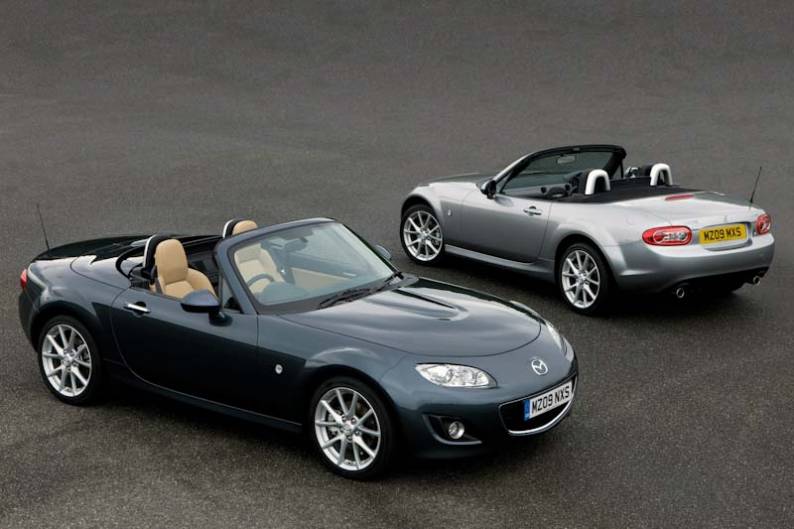
RAC sale – up to 33% off*
• Roadside cover from £5.29 a month†
• We get to most breakdowns in 60 mins or less
• Our patrols fix 4/5 breakdowns on the spot

BY STEVE WALKER
Introduction
Convertibles are, by their very nature, love it or hate it kinds of vehicles and on the used market, their polarising effects can be multiplied. Mazda's MX-5 roadster has always done a creditable job of attracting those who fall into the 'love it' camp with its sparkling driving experience and affordability but people who prefer to be insulated from the elements by something more substantial than a few millimetres of material routinely gave it the cold shoulder. Mazda's answer was the Roadster Coupe, a version of the MX-5 with a folding hardtop roof. At a stroke, it made Mazda's little sports car more appealing to drop-top doubters and as a used buy, it's perceived as a more substantial proposition than the soft top.
Models
Models Covered:
MX-5 Roadster Coupe - 2006 to date: 2 door roadster-coupe [1.8, 2.0-litre petrol (base, Sport)]
History
The third generation Mazda MX-5 model debuted in September 2005 and although it was a little bigger and heavier than previous generations, the styling rejuvenated the car, bringing a little more edginess to proceedings. The introduction in September 2006 of the Roadster-Coupe model with the folding hard top roof further broadened the appeal to customers who wanted the handling of the MX-5 but weren't enamoured of a fabric roof. Offered with the same 1.8 and 2.0-litre petrol engines as the standard models, the Roadster Coupe presented MX-5 buyers with a straight choice - soft-top or not.
What You Get
The Roadster Coupe's powered folding roof retracts in three sections with no impact on boot space and adds just 37kg to the weight of an equivalent soft top MX-5 roadster. Raise the roof and it sits a mere centimetre taller than its fabric-trimmed sibling. In short, the arrangement isn't overly intrusive.
Although it's tempting to think of this car as 'just a roof', a lot of thought clearly went into it. The spring and damper settings were subtly revised to take account of the hard top car's marginally altered weight distribution. Thankfully, the roof retracts to a position within the wheelbase of the car so that it doesn't detract too markedly from handling agility. That said, Mazda concentrated on giving this MX-5 a smoother and milder road feel, targeting it at those who value refinement.
Park the Roadster Coupe and the MX-5 soft top next to each other and it's possible to see the subtle way in which Mazda has teased out the shape to accommodate the folding roof. The rear deck of the car sits 40mm higher at the rear window line and 20mm higher at the trailing edge of the boot, giving it a slightly more hunched and powerful look than the soft top. It's really a very minor change and tough to discern in isolation.
Whereas the average duration for a roof operation of this kind tends to be around 22 seconds, Mazda whittled that time back to a mere 12 seconds for the MX-5 Roadster Coupe, making it the fastest folding hard top in the world at the time of its launch. The driver must unlatch a centre lock and then press a button to operate the roof but it can easily be done while waiting at lights. The roof itself is composed of three panels; a front roof section, a middle roof part and a window assembly. Highly formable yet stiff plastics were required to keep weight low and durability high.
What You Pay
Please fill in the form here for an exact up-to-date information.
What to Look For
The Roadster-Coupe roof mechanism should work quickly with no need for manual alignment. Mazda raised the ride height of the MX-5 by 30mm to pass EU pedestrian crash tests. Apparently the car handles far better when returned to the factory ride height. Not that we would condone such antisocial behaviour.
With the MK2 MX-5, there were all sorts of pitfalls regarding parallel imports and jazzed-up used examples, problems that you tend not to have to look out for with the third-generation model. Just make sure that the car has been serviced on the button, hasn't been crassly modified and hasn't suffered accident damage. It's also quite easy to immolate a set of rear tyres if you know how to disable the stability control and have found a deserted airfield or benign roundabout, so make sure there's some tread on the rears.
Replacement Parts
(approx based on a 2006 MX-5 1.8i Roadster Coupe ex Vat) A clutch assembly is around £200 and an exchange alternator about £225 while a starter motor is around £150. A door mirror is about £125 and a windscreen is just under £130.
On the Road
Five basic requirements were defined to realise the third-generation MX-5 design criteria. Firstly the car would be as light as possible while meeting global safety requirements. Next, the cockpit would comfortably accommodate two full stature occupants with no wasted space. The basic layout would continue with the original's front-engine rear-wheel drive configuration with the engine positioned ahead of the driver but behind the front axle for a 50:50 front to rear weight distribution. All four wheels would be attached by wishbone or multi-link suspension systems to maximize tyre performance, road grip and dynamic stability. Finally, the chassis would provide a solid connection between the engine and the rear mounted differential to sharpen throttle response.
That the MK3 MX-5 scores in these departments is obvious from its basic details. The engine moved back fully 135mm for better weight distribution, while chassis torsional rigidity goes up by 47 per cent. Rather than concentrate on kilograms saved, Mazda insisted that every component would be weighed in grams. Take care of the grams and the kilos look after themselves. The 125bhp 1.8-litre alternative is far sweeter and rewards hard driving more vocally.
With a 0-60mph acceleration time of 9.4s, there's plenty of scope to explore the 1.8-litre MX-5's potential without entering licence confiscation territory. The 2.0-litre unit is capable of 0-60mph in 7.9 seconds which is still fairly tame by today's standards. Neither car will trouble any of the top-line hot hatchbacks that are currently available in a traffic light face off. The entry level car has a 122mph top speed compared to 130mph in the range-topper.
Overall
The Mazda MX-5 is a cracking little roadster and buyers looking for such a car in this price range don't really have too many other options at their disposal. Having seen off the competition, the MX-5 began to diversify and the Roadster Coupe model certainly broadened the car's appeal. If you've doubts about used soft tops, especially soft-tops that have seen a bit of use, the Roadster Coupe version of the MX-5 neatly solves the problem.






![Mercedes-Benz SL 63 AMG [R231] (2016 - 2020) used car review](https://d1ix0byejyn2u7.cloudfront.net/drive/images/made/drive/images/remote/https_d2yv47kjv2gmpz.cloudfront.net/filestore/9/2/0/2_1235e6526d5921b/a14145224a8852086125fdd0cd22e095/2029_262cbd236042267_100_100_70_c1_c_c.jpg)
